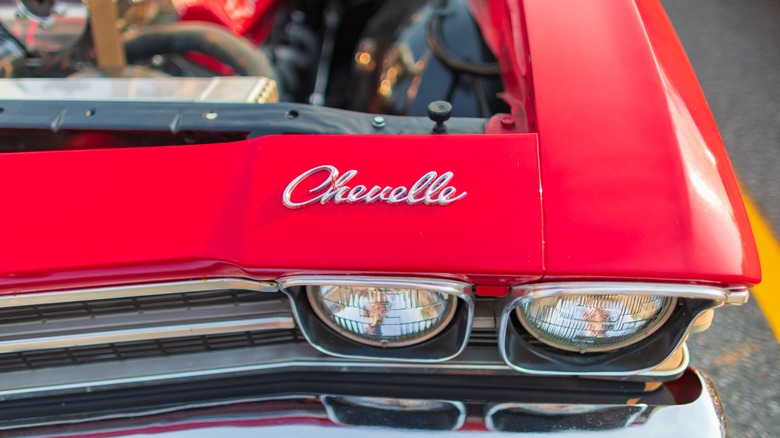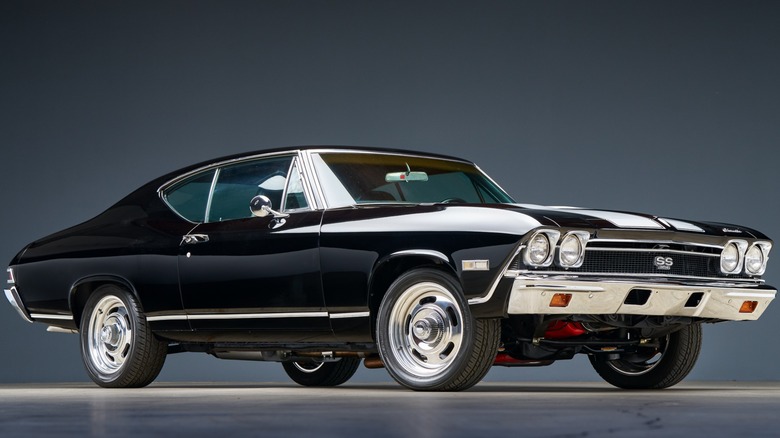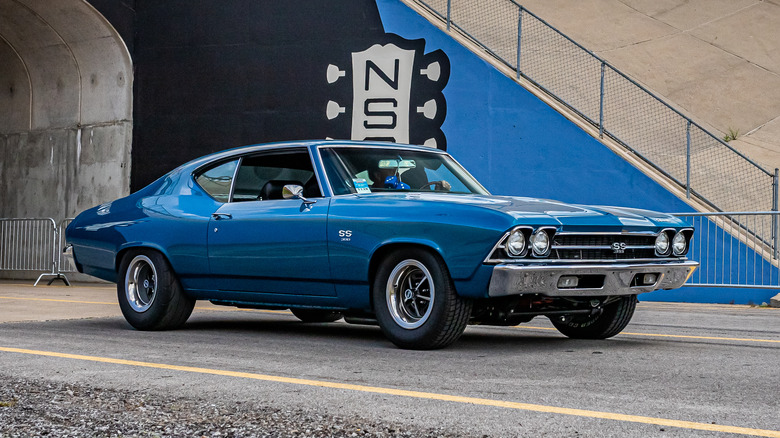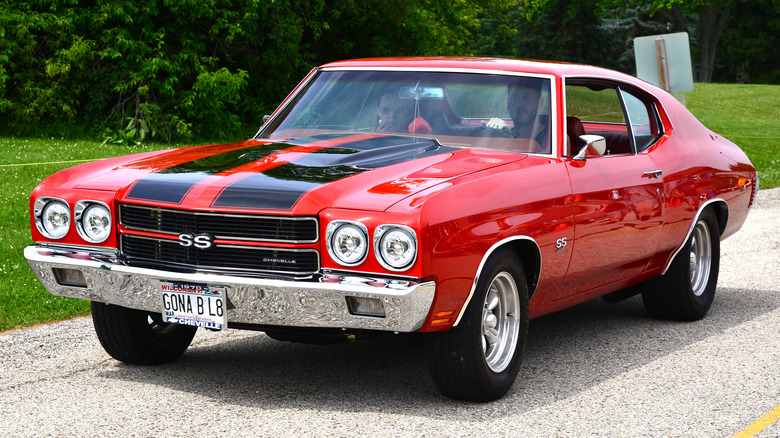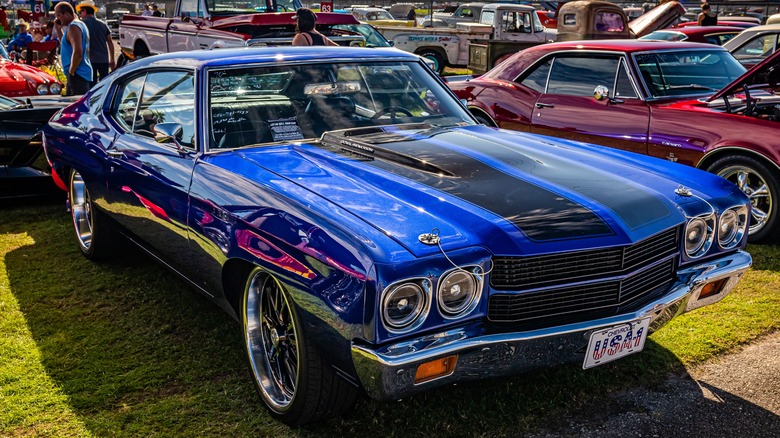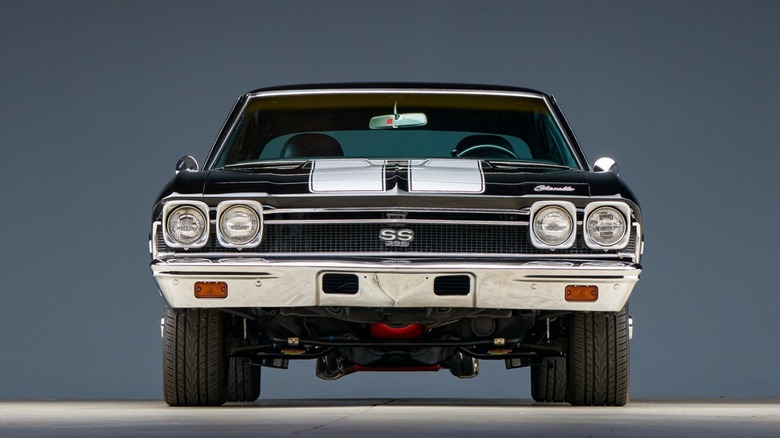Everything Chevy Fans Should Know About The Second Generation Chevelle
The mid-1960s and early 1970s were a golden era of American car building that we may never see the likes of again. Born of dominant American industrial might, low gas prices, and distinctive design tenets, the muscle era produced some of the most famous cars in automotive history, and few ranked as high in legendary status as Chevrolet's Chevelle.
The first generation of Chevelles hit the streets in 1964, just at the dawn of the muscle car revolution. Chevrolet sought a mid-sized offering to slot between its full-sized Impala and compact Nova. The original Chevelle displayed true straight lines, a raked-forward front end, and an initial power rating of 220 horsepower. Chevrolet built the first generation Chevelle for model years 1964 through 1966, but it soon became clear that the 220 horsepower, 283-cubic-inch displacement V8 could not keep up in the power race of the late 1960s. By 1966, there were options for 325, 360, or 375 horsepower options, including the praised SS396. However, there was stiff competition for mid-sized muscle — the likes of the GTO, Skylark, Cutlass, and SuperBee cut into the Chevelle pie. Chevrolet would need to revamp for 1968 if it wanted to keep up with the competition.
Second generation 1968-1972
For model year 1968, the Chevelle got a new look. The most marked difference in appearance can be attributed to the banishment of the straight rear fenders and long, flat rear deck. Designers installed curved rear haunches and a fastback-style trunk. The car looked like it was in motion, even parked, and the sleek look hit with consumers.
The Chevelle is most closely associated with classic muscle, but the truth is the second generation was surprisingly versatile. From 1968-1972, Chevrolet offered several body styles, including sedans, coupes, station wagons, and convertibles. Across the line, consumers had a choice of 10 engine options, including two six-cylinder and eight eight-cylinder engines.
Many aficionados consider the second-generation Chevelle the high-water mark for the nameplate. It's what comes to mind when most people think of a Chevelle, and it's not unusual to see the 1970 Chevelle SS LS6 acclaimed as one of the most desirable muscle cars ever. In 1968, at the height of the muscle craze, Chevrolet built nearly 384,000 Chevelles, with a further 455,000 following for 1969 and over 634,000 for 1970 before dipping to 387,000 for 1971. Numbers for 1972 are difficult to ascertain because Chevrolet included Monte Carlo production in their reporting.
The second-generation Chevelle swept onto the market and into the daydreams of young drivers with gasoline in their veins. It was modern, powerful, and poised for the height of muscle mania.
Identifying a second-generation Chevelle
Each of the three Chevelle generations, which ran between 1964 and 1977, had a distinct look. The major redesign for 1968 eliminated the stalwart, blocky lines of the street-fighting first generation and played with a longer hood, sloping, muscular rear fenders, and a shorter wheelbase and trunk deck that made it look like it wanted to spring from the starting line. There were four model years for the second generation, which, at a glance, look pretty similar. One of the best ways to determine the year is to look at the front end.
The first year of the restyle included an egg crate mesh grille, while 1969 models and beyond employed horizontally split grills and, crucially, lost the triangular vent window after Chevrolet introduced its Astro Ventilation air system. The latter half of the second generation saw a restyling that set them apart from the '68 and '69 models. In 1970, the deck lid and rear fenders changed slightly for a fatter look. Then, in 1971, the dual headlights switched to singles, and the taillights turned from single rectangles to double circles. For 1972, Chevrolet finished the generation with solid signal lenses in front.
It's not always a snap to tell exactly which second-generation Chevelle you're looking at. If you can look at the VIN number, the eighth number of a second-generation Chevelle indicates the year of production. For example, a "9" in the eighth digit of the VIN indicates a 1969 model, while a "0" would be present for 1970.
Trim and engines
The Chevelle was a surprisingly diverse automobile. Throughout its lifetime, fewer than 10 engine options and a selection of coupes, sedans, convertibles, and even wagons gave buyers many options. For 1968, Chevrolet offered the 300, 300 Deluxe, Nomad, Concours, Malibu, and SS 396. Any of the models could come equipped with the standard six-cylinder, 140 horsepower Turbo-Thrift (aside from the SS) or any of a line of V8s, which included options up to a 396-cubic-inch engine producing up to 375 horsepower. Consumers could also choose a number of interior and exterior color options. The options for 1969 remained much the same — the Malibu was considered the luxury model, and the Super Sport with its 396 was as big as the Chevelle would get until 1970.
Things changed in 1970. Along with the restyling, Chevrolet made a huge splash by putting one of the most legendary V8 big-blocks of all time into a car already destined for museums — the 1970 Chevelle SS 454. The 454 big-block cost buyers an additional $503 (MSRP ranged between $3,000 and $4,000), and it may be the pinnacle of muscle power. Shelling out for the top-tier LS6 would have been a good investment, with 450 horsepower and 500 pound-feet of torque to enjoy. Surviving examples fetch nearly six-figure prices in the modern era.
It also marked the final production year before the Clean Air Act of 1970, which hamstrung big-displacement engines and saw Chevy go out in style.
Reception and impact
Alas, by 1972, the final year of the second-generation Chevelle, the glory days of the muscle car era had passed. The Chevelle would live on for another five years, but there is little debate the party was over after 1972. The legendary car faded from glory as the 1980s approached, eventually rebranding as the Malibu in 1978.
The second-generation Chevelle hit that sweet spot between the rise and development of muscle cars and their ultimate death to regulation. Perhaps this ignominious downfall makes the Chevelle echo so loudly in the halls of automotive memory. It's one of the few cars (along with several of its muscle fraternity) that gains value each year. Sure, it appeals to baby boomers who wish to relive the glory of their youth, but the Chevelle is much more than a nostalgic relic. It's the poster child of an era, a breath of the 1960s and 1970s injected into modernity.
They're still out of production, and they have become so desirable there's a high entry barrier for owning one. The average price of a second-generation Chevelle on the market today is north of $75,000, while the top sale on record is a whopping $600,000. Chevelles are slowly becoming more museum pieces than road machines. Still, an enterprising wrench-turner with a nice garage could pick up a project for less than $10,000, though it's unlikely that number will dip anytime soon.
Chevelle aftermarket
As the used prices suggest, the Chevelle aftermarket is absolutely thriving. With original cars becoming more and more valuable, there are still many build options to choose from for those willing to Frankenstein a Chevelle together. One of the nice things about muscle cars as projects is their enormous engine bays can fit just about anything, and it's not like there's a shortage of wrecked Chevrolet V8s lying around.
Dozens of companies supply aftermarket parts for just about any system found in the Chevelle, and the message board and YouTube communities for building and appreciating these cars is as healthy as ever. Sure, the rarest models of the most desired generation of Chevelles have reached astronomical prices. But building or restoring one is not yet out of the question for the amateur or hobbyist who wishes to own one of the most iconic American muscle cars of all time.
Check out some of the most impressive Chevy muscle cars of all time.
